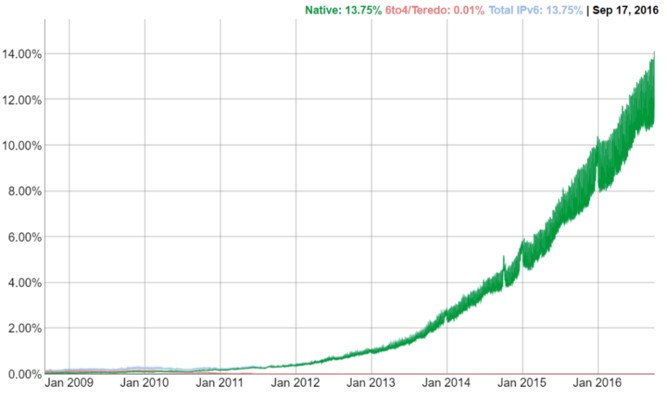I still remember the day of the IPv6 switchover on June 6, 2012. I was with some friends and we were casually checking our phones to see whether or not the Internet would go down. That didn’t happen of course, and it’s interesting to see how far we’ve come along on the IPv6 adoption path. My prediction is that the first planet with 100% IPv6 penetration will be Mars.
Today, the standard is to have dual stack Internet Protocols supporting both IPv4 and IPv6. There is no plan or set date for a complete switch to IPv6. That day may come at some point or IPv4 might just become obsolete when the IPv6 penetration reaches 100% of the Internet and IPv4 addresses stop being issued.
On this graph, we see the percentage of users that access Google over IPv6 to access.

[source: https://www.google.com/intl/en/ipv6/statistics.html]
Considering Google’s traffic volume from around the world, it must be pretty accurate to say that today the IPv6 adoption reaches almost 14% worldwide with an accelerating year over year adoption rate.
IPv6 Adoption by Country
Google also has the following map, which breaks down the adoption per country:

[source: https://www.google.com/intl/en/ipv6/statistics.html]
It’s notable that Google tracks which countries have some IPv6 adoption, but users experience significant reliability and latency issues. This reveals one of the reasons that holds back IPv6 adoption: many countries and organizations go through a very careful and slow switch to IPv6 in order to avoid performance and security issues. For example, the recently introduced OnHub, Google’s WiFi router, doesn’t support IPv6. Yet… If Google is not ready to fully support IPv6 in a 2016 product, then we can excuse everyone else. I am sure that a not-so-distant firmware upgrade will add IPv6 support.
IPv6 Adoptions by Internet Service Provider
In terms of service providers, we see that the world’s ten largest providers have varying rates of adoption, from 18% to 75%.
In the US, Verizon is the clear leader with 75% and a very wide gap compared to the other nationwide service providers.To the extent of my imagination, IPv6 has the capacity (2^128 ~= 3.4×10^38 addresses) to support all possible hosts on planet Earth, Mars, and the first few interstellar colonies. IPv6 adoption is accelerating and within a couple of decades, we’ll be close to 100% coverage as old equipment goes offline and new software and hardware comes with full IPv6 support. However, IPv4 support will stay around for a while for backwards compatibility and to remind us of the dawn of the Internet.
| 1 | 45.10% | Comcast Cable |
| 2 | 39.40% | AT&T Communications Americas |
| 3 | 23.20% | Time Warner Cable Inc. |
| 4 | 74.60% | Verizon Wireless |
| 5 | 20.30% | Intelekto/GVT |
| 6 | 59.60% | Sky Broadband |
| 7 | 67.80% | T-Mobile |
| 8 | 18.50% | UPC |
| 9 | 18.30% | Cox Communications Inc |
[source: https://www.akamai.com/us/en/our-thinking/state-of-the-internet-report/state-of-the-internet-ipv6-adoption-visualization.jsp]
In the US, Verizon is the clear leader with 75% and a very wide gap compared to the other US nationwide service providers.
To the extent of my imagination, IPv6 has the capacity (2^128 ~= 3.4×10^38 addresses) to support all possible hosts on planet Earth, Mars, and the first few interstellar colonies. IPv6 adoption is accelerating and within a couple of decades, we’ll be close to 100% coverage as old equipment goes offline and new software and hardware comes with full IPv6 support. However, IPv4 support will stay around for a while for backwards compatibility and to remind us of the dawn of the Internet.





